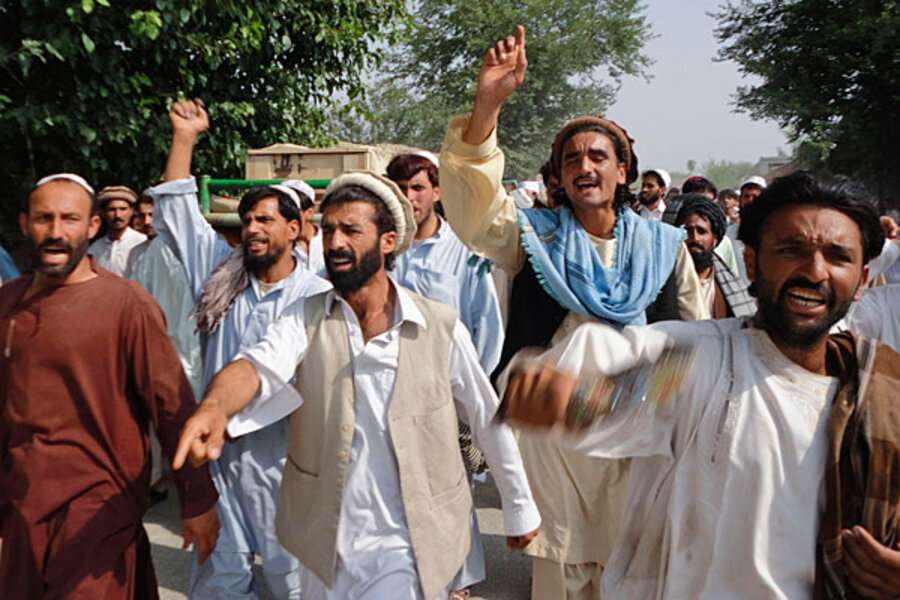How Afghanistan civilian deaths have changed the way the US military fights
Loading...
| Bagram, Afghanistan
In Afghanistan, the accidental killing of civilians by the US military has repeatedly put America’s war strategy at risk.
Top US commanders recognize this, and they’ve created rules of engagement to minimize the chances that children and other innocent bystanders are caught in the path of bombs and strafing fire.
Although they’ve had some success, a recent United Nations report has plenty of troubling news. Civilian deaths and injuries in Afghanistan rose by 20 percent – to 1,090 killed and more than 1,800 wounded – between the spring of 2010 and the spring of 2011.
But the proportion of civilians killed by the military has declined, according to the report. The actions of the US military and NATO forces accounted for 10 percent of civilian casualties over the same period, versus 16 percent the year before.
The experience of a decade of war has helped drive home the impact of accidental killings, says Col. Clay Hall, commander of the 455th Expeditionary Operations Group, who has served tours of duty in both Iraq and Afghanistan. “When the war kicked off here and in Iraq, we were less concerned about that,” he adds. “When we start off wars, we’re in an offensive mind-set.”
Now, everyone in the service – from the most junior troop on up – knows that the goal is to stabilize the country, Hall adds, “and it’s pretty hard to do that when you’re dropping bombs on innocent people.”
Commanders also emphasize the far-reaching consequences of a single mistake. “[Afghan President Hamid] Karzai’s making a statement, and [Gen. David] Petraeus is apologizing to the president” for an incident involving civilian casualties, says Lt. Col. Daren Sorenson, deputy commander of the 455th. “They can see how quickly a tactical mistake has a strategic-level impact.”
But caution doesn’t always come naturally in the heat of battle. And so during training, joint terminal attack controllers (JTACs) – Air Force specialists who embed with US military infantry units to help them call in airstrikes during battle – learn how to navigate what may quickly become ethical gray areas.
During role-playing, an instructor might act as a ground-force commander, yelling at the JTAC to call for fire on a building where enemy forces have taken cover. When the JTAC asks if civilians are in the building, the ground commander ignores him, insisting that they must strike immediately or risk an enemy escape.
“We’re yelling, ‘Hey Air Force, where’s my air?’ and ‘I got intel – I want to take it out now!’ I’m throwing him off thinking about the civilians, when he should be,” says Senior Master Sgt. Javier Soto, a JTAC who has worked with Special Operations Forces and is also an instructor.
“Long story short, the building gets hit, but it hits good guys and bad guys.” Next, Soto says, the JTAC learns of his mistake. “So we’ll scream at him and all sorts of good stuff,” he adds. “It works.”
Technology can help, too, in real-life incidents. For example, in the headquarters building of the 455th Expeditionary Operations Group here, airmen play a grainy video of a compound that houses insurgents who have been planting roadside bombs. They watch the compound, make sure it is clear of innocents, and then fire a 500-pound, laser-guided bomb to kill the insurgents.
But after the bomb, known as a joint direct attack munition (JDAM), is launched, a civilian bicycles into the blast zone. With just seconds to spare, the operators are able to direct the GPS laser-guided bomb away from the civilian, into an open field, where it detonates without harming anyone. “There are things like this that happen every day,” Hall says.
At one time, rules of engagement “weren’t as strict,” Soto acknowledges. “A commander could go down there and just lay waste to all the bad guys. If it didn’t go well” – in other words, if civilians were injured or killed – “you’d have your PA [public affairs] folks smooth things out,” he says. “It didn’t get national attention.”
Stringent rules of engagement also have benefits for the troops in the field, Soto adds. When civilians are hurt as a result of US strikes, “It gets really hard,” he says. “It weighs heavy on us.”





